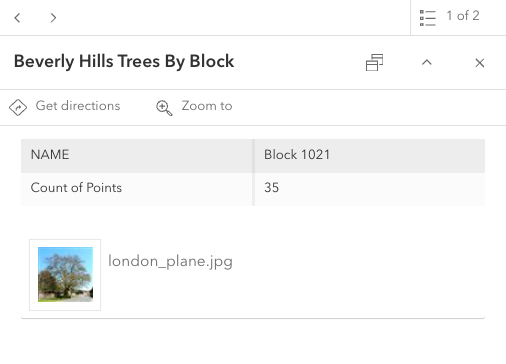require(["esri/rest/query/support/AttachmentInfo"], (AttachmentInfo) => { /* code goes here */ });
import AttachmentInfo from "@arcgis/core/rest/query/support/AttachmentInfo.js";
esri/rest/query/support/AttachmentInfo
The AttachmentInfo class returns information about attachments associated with a
feature. The contents of the attachment are streamed to the client.
Attachments are available if the FeatureLayer.capabilities.data.supportsAttachment
is true.

Constructors
-
Parameterproperties Objectoptional
See the properties for a list of all the properties that may be passed into the constructor.
Property Overview
| Name | Type | Summary | Class |
|---|---|---|---|
The content type of the attachment. | AttachmentInfo | ||
The name of the class. | Accessor | ||
An array of ExifInfo for the attachment. | AttachmentInfo | ||
The global identifier for the attachment. | AttachmentInfo | ||
The identifier for the attachment. | AttachmentInfo | ||
Keywords used for the attachments. | AttachmentInfo | ||
String value indicating the name of the file attachment. | AttachmentInfo | ||
The OrientationInfo for the attachment. | AttachmentInfo | ||
The parent or the feature global id of the attachment. | AttachmentInfo | ||
The parent or the feature object id of the attachment. | AttachmentInfo | ||
The file size of the attachment. | AttachmentInfo | ||
The URL of the attachment. | AttachmentInfo |
Property Details
-
contentType
PropertycontentType String -
The content type of the attachment. For example,
'image/jpeg'. See the ArcGIS REST API documentation for more information on supported attachment types.
-
globalId
PropertyglobalId String -
The global identifier for the attachment.
-
id
Propertyid Number -
The identifier for the attachment.
-
keywords
Propertykeywords String -
Keywords used for the attachments.
-
name
Propertyname String -
String value indicating the name of the file attachment.
-
orientationInfo
PropertyorientationInfo OrientationInforeadonly -
The OrientationInfo for the attachment. This is derived from the exifInfo. In order to read this, you must first set the attachment query's returnMetadata to
trueto get theexifinfo associated with the attachment.
-
The parent or the feature global id of the attachment.
-
The parent or the feature object id of the attachment.
-
size
Propertysize Number -
The file size of the attachment. This is specified in bytes.
Method Overview
| Name | Return Type | Summary | Class |
|---|---|---|---|
Adds one or more handles which are to be tied to the lifecycle of the object. | Accessor | ||
Creates a deep clone of the AttachmentInfo class. | AttachmentInfo | ||
Creates a new instance of this class and initializes it with values from a JSON object generated from an ArcGIS product. | AttachmentInfo | ||
Returns true if a named group of handles exist. | Accessor | ||
Removes a group of handles owned by the object. | Accessor | ||
Converts an instance of this class to its ArcGIS portal JSON representation. | AttachmentInfo |
Method Details
-
Inherited from Accessor
Since: ArcGIS Maps SDK for JavaScript 4.25Accessor since 4.0, addHandles added at 4.25. -
Adds one or more handles which are to be tied to the lifecycle of the object. The handles will be removed when the object is destroyed.
// Manually manage handles const handle = reactiveUtils.when( () => !view.updating, () => { wkidSelect.disabled = false; }, { once: true } ); this.addHandles(handle); // Destroy the object this.destroy();ParametershandleOrHandles WatchHandle|WatchHandle[]Handles marked for removal once the object is destroyed.
groupKey *optionalKey identifying the group to which the handles should be added. All the handles in the group can later be removed with Accessor.removeHandles(). If no key is provided the handles are added to a default group.
-
clone
Methodclone(){AttachmentInfo} -
Creates a deep clone of the AttachmentInfo class.
ReturnsType Description AttachmentInfo A deep clone of the AttachmentInfo instance.
-
Creates a new instance of this class and initializes it with values from a JSON object generated from an ArcGIS product. The object passed into the input
jsonparameter often comes from a response to a query operation in the REST API or a toJSON() method from another ArcGIS product. See the Using fromJSON() topic in the Guide for details and examples of when and how to use this function.Parameterjson ObjectA JSON representation of the instance in the ArcGIS format. See the ArcGIS REST API documentation for examples of the structure of various input JSON objects.
Returns
-
hasHandles
InheritedMethodhasHandles(groupKey){Boolean}Inherited from AccessorSince: ArcGIS Maps SDK for JavaScript 4.25Accessor since 4.0, hasHandles added at 4.25. -
Returns true if a named group of handles exist.
ParametergroupKey *optionalA group key.
ReturnsType Description Boolean Returns trueif a named group of handles exist.Example// Remove a named group of handles if they exist. if (obj.hasHandles("watch-view-updates")) { obj.removeHandles("watch-view-updates"); }
-
Inherited from Accessor
Since: ArcGIS Maps SDK for JavaScript 4.25Accessor since 4.0, removeHandles added at 4.25. -
Removes a group of handles owned by the object.
ParametergroupKey *optionalA group key or an array or collection of group keys to remove.
Exampleobj.removeHandles(); // removes handles from default group obj.removeHandles("handle-group"); obj.removeHandles("other-handle-group");
-
toJSON
MethodtoJSON(){Object} -
Converts an instance of this class to its ArcGIS portal JSON representation. See the Using fromJSON() guide topic for more information.
ReturnsType Description Object The ArcGIS portal JSON representation of an instance of this class.
Type Definitions
-
An array of Exchangeable image file format information for the attachment. You must set the attachment query's returnMetadata to
trueto get theexifinfo associated with the attachment.
-
An object containing properties specific to the orientation of an image attachment. This information is stored within the attachment's exifInfo. In order to read this, you must first set the attachment query's returnMetadata to
trueto get theexifinfo associated with the attachment.